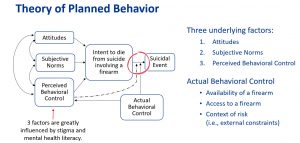Firearm-Related Experiences and Perceptions Among U.S. Veterans
 The Northwest Pennsylvania (NW PA) Veteran Suicide Prevention Program operates on a three-pronged approach involving healthcare providers, community organizations, and Veterans and their families in the 15 counties of NW PA.
The Northwest Pennsylvania (NW PA) Veteran Suicide Prevention Program operates on a three-pronged approach involving healthcare providers, community organizations, and Veterans and their families in the 15 counties of NW PA.
This article summarizes a research presentation by Patti Tanner, Senior Program Implementation Specialist, and explores the following topics:
- Firearm ownership and suicide involving a firearm, by Veteran-status and gender.
- Are firearm owners more suicidal than non-owners?
- How the theory of planned behavior impacts suicide risk.
- How behavior controls and changes to the environment can mediate an individual’s suicide risk based on the theory of planned behavior.
Read time: 7 minutes
A pdf of the presentation, including sources, is available for download.
Veterans and firearms
Veterans have a high degree of familiarity with firearms. Nearly 45 percent of Veterans report owning guns compared to 20 percent of non-Veterans. Veterans are also more likely to die by firearm suicide. On average, two-thirds (68.6 percent) of suicides among Veterans are by firearm, compared to non-Veteran adults, where about half of all suicides are with a firearm.
Based on data from 2019, women Veterans were 2.2 times more likely than women non-Veterans, and Veteran men were 1.5 times more likely to die by suicide than their non-Veteran peers. (OMHSP, 2019)
Are firearm owners more suicidal than non-owners?
 Research shows this is not the case. People who live in homes with guns are not more likely to experience a mental health problem. They are not more likely to seriously consider suicide, and they are not more likely to attempt suicide.
Research shows this is not the case. People who live in homes with guns are not more likely to experience a mental health problem. They are not more likely to seriously consider suicide, and they are not more likely to attempt suicide.
More than 15 U.S. case-control and cross-sectional studies have found that firearm access is an independent risk factor for suicide.
Firearm ownership rates largely determine variations in suicide mortality across all 50 states, independent of underlying rates of suicidal behavior. (Miller et al., 2013; Simonetti et al., 2018)
Theory of planned behavior and suicide risk
In the theory of planned behavior, three factors influence one another regarding suicide risk.
- Attitudes
- About using firearms.
- Beliefs about the consequences of suicide/suicide by firearm.
- Acceptability of suicide by firearm.
- Motivation to comply with these norms.
- Subjective norms
- Beliefs about how family and friends perceive suicide/suicide by firearm.
- Acceptability of suicide by firearm.
- Motivation to comply with these norms.
- Perceived behavioral control
- Self-efficacy to avoid self-harm/impulse control.
- Perceived lethality of suicide involving a firearm.
- Confidence in the ability to complete the suicide attempt with a firearm.

These three factors are influenced by stigma and mental health literacy.
Firearm lethal means safety and safe storage interventions
 Based on the facts presented in the theory of planned behavior, behavior controls and changes to the environment can mediate an individual’s suicide risk in each area.
Based on the facts presented in the theory of planned behavior, behavior controls and changes to the environment can mediate an individual’s suicide risk in each area.
Examples of behavioral control:
- Temporarily reducing the availability of a firearm through Extreme Risk Protection Orders (ERPO). ERPOs allow immediate family members and law enforcement to petition for a court order to temporarily remove firearms during times of crisis.
- Promoting firearm safe storage practices. Encouraging safe storage practices (unloading the ammunition, locking the firearm, and storing the firearm and ammunition in separate locations) puts time and distance between those at risk and their firearms.
- Context of risk. Understanding the background and context of the individual’s suicide risk (level of family/community trust and involvement, pre-existing social and protective functions, and experience with military sexual trauma or intimate partner violence) can help determine which external behavioral constraints will be most effective.
Looking to Get Involved?
 Whether you identify as a healthcare provider, community organization, or Veteran, there are several opportunities through the NW PA Veteran Suicide Prevention Program and PERU to connect to resources, participate in educational training, and promote harm reduction strategies. We are actively recruiting healthcare and community partners to work with us in meeting our goals and objectives. To learn more, visit the program website at theresilientveteran.org.
Whether you identify as a healthcare provider, community organization, or Veteran, there are several opportunities through the NW PA Veteran Suicide Prevention Program and PERU to connect to resources, participate in educational training, and promote harm reduction strategies. We are actively recruiting healthcare and community partners to work with us in meeting our goals and objectives. To learn more, visit the program website at theresilientveteran.org.
Need Help? Know Someone Who Does? Contact the National Suicide Prevention Lifeline at 988 or use the online Lifeline Crisis Chat. Both are free and confidential. You’ll be connected to a skilled, trained counselor in your area.

